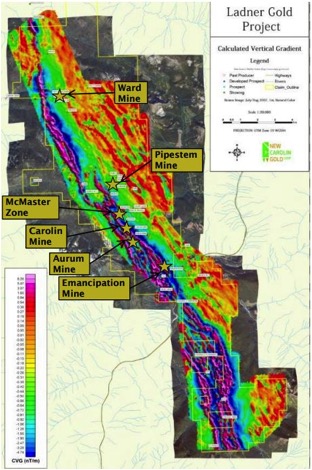Tons Of Gold Hiding In Plain Sight…
New Carolin Gold (LAD.V; LADFF.OB) controls a project with hundreds of thousands of ounces of gold near world-class infrastructure.
So far, the market isn’t giving the company anywhere near full credit for its assets, but it seems that’s about to change…
Dear Fellow Investor,
Sometimes the best place to look for gold is in your own backyard.
That’s the tack that Vancouver-based New Carolin Gold is taking with its Ladner project, located a short-drive away near Hope, B.C.
Vancouver is home to hundreds of junior explorers with projects spread across the planet. So why did New Carolin elect to look for gold so close to home?
Because, in spite of the project’s proximity to the mining exploration industry, Ladner and the Coquihalla Gold Belt it lies upon remain significantly under-explored.
As a result, New Carolin was able to wrap up a huge, 150-square-kilometer land package in the region, giving it access to a district-scale gold system along the Hozameen Fault, an area checkered with multiple, past-producing underground mines.
A Near-Perfect Setting For A Mine
If you were going to pick a location to build a gold mine, you’d be hard-pressed to find a better infrastructure setting than New Carolin has with Ladner.
Its project lies just two hours by freeway from Vancouver and 15 minutes by freeway from mining-friendly Hope.
Hydroelectric power runs to the property line, and the potential exists for the company to build its own small run-of-river power facility at the mill site. Because it’s British Columbia, water is in abundance, and New Carolin has all the valid water licenses it needs for the project.
The past production has left a permitted tailings storage facility in place, and Ladner’s Carolin underground mine has crushers at the entrance to the 775-meter level. The mine also contains an intact foundation, ball mill, rod mill and regrind mill.
Better yet, the area’s 125 years of mining and logging activity provides an employment base and a heavy road infrastructure that will readily support new gold mining in the area.
Moreover, because roughly 65% of the target development zones at Ladner have been logged, remaining environmental and permitting issues should be much less onerous.
A District-Scale Property...
Ladner covers a 28-kilometer by 5-kilometer stretch of British Columbia’s Coquihalla Gold belt. The Hozameen Fault is the key structure on the property, hosting five historical mines and 30 known gold workings.
In spite of that history, however, only the Carolin Mine and McMaster Zones have seen extensive drilling. And yet there’s the potential for much more, as New Carolin’s geologists are excited about the property’s large geophysical and geochemical signature.
Take a look at this magnetic survey taken of the property.

The purple and blue areas are ultramafic and sediment rock types, and as you can see, the mines found to date on the property are largely in contact with the purple (ultramafic) areas associated with the Hozameen Fault.
New Carolin believes it can use drilling to begin establishing mineralization below (and connections between) the mines and gold showings on the property. The vast majority of these targets have never been explored using modern exploration techniques.

...With Historic Gold Production
In addition to Carolin, Ladner includes the Arum, Emancipation and Pipestem mines, which were active largely in the early part of the 20th Century. The exception was Carolin, which produced 44,000+ ounces of gold between 1982 and 1984.
McMaster and Carolin saw another round of drilling in the mid-1990s, when Athabasca Gold conducted $3.5 million in work programs. That effort included over 8,500 meters of underground drilling and some tunneling and drifting as well.
Athabasca was able to show the McMaster Zone was open in all directions. This prior owner also made a significant contribution to the drill-hole database for Carolin, which has seen 600+ holes drilled.
From that work, Carolin has an NI 43-101 compliant resource estimate of 607,000 inferred ounces of open-pittable gold or, in a higher-grade underground mining scenario, 278,000 inferred ounces of gold. The McMaster Zone contains an inferred mineral resource of 79,500 ounces of gold.
That’s a great base to start from — and New Carolin is already working to increase the size and confidence level of Carolin’s resource.
Drilling Is Underway Now
We won’t have to wait long for news from Carolin. An initial 1,000-meter underground program on the mine is underway as we speak.
The company will leverage existing underground access at the mine to drill an area of mineralization that has generated intercepts as high as 9 meters of 11.4 g/t gold and 7.1 meters of 6.43 g/t gold.
This Phase 1 program will seek to expand the known resource by confirming historic drill intercepts on the Main Zone, test the northern extent of the mine’s East Zone and conduct step-outs below the Lower Zone.
Phase 2 will follow quickly upon this work with an additional 2,500 meters to further test the Lower and East Zones and evaluate the Hozameen Zone on the mine.
The company will then incorporate this data into a new resource estimate for Carolin. Given its deep understanding of the project and the surrounding geology of the area, an estimate that surprises the market to the upside is a distinct possibility.
In short order, it will dawn on investors that New Carolin has laid a hold of a large and expandable gold district just a couple of hours away from Vancouver.
Those who position themselves in New Carolin Gold prior to that report’s release may be very glad they did.
CLICK HERE
To Learn More about New Carolin Gold
|



